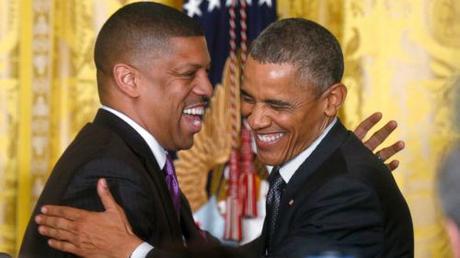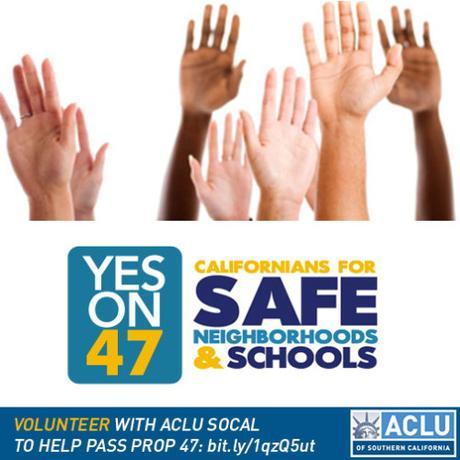You think reducing crimes from felonies to misdemeanors and releasing 17,000 low-level criminals from jails or prisons might be part of the problem?

Sacramento Mayor Kevin Johnson and his buddy Obama
Sacramento Bee: Ninety minutes after midnight on a recent Saturday, Sacramento resident Jackie Andersen learned that her son – a lively 16-year-old student at American Legion High who played football and basketball – was dying. “I got woken up by my oldest son,” she said. “His brother was shot and unresponsive and bleeding.”
Isaiah Diaz was gunned down in front of his grandmother’s house in the city’s Colonial Village neighborhood in the early hours of Oct. 3. Police say they believe the shooting was gang-related; Andersen said her son was not in a gang, but may have been “hanging out with the wrong people.”
It was the seventh killing in the city in five weeks and the 35th homicide of 2015. That amounts to more homicides by early October than Sacramento has seen during the first nine months of any year since 2008.
The killing and Thursday’s downtown stabbing of French train attack hero Spencer Stone are the latest indications of a disturbing trend: Violent crimes – murder, rape, robbery and aggravated assault – are up sharply this year in Sacramento.
Through August, Sacramento police had responded to 2,511 violent crimes, a 24 percent increase from the same period in the prior year, police statistics show. The city has not seen that many violent crimes through August of any year since 2010.
Violent crime is up year-over-year in each of the city’s six patrol districts, but the increase is not uniform. In North Sacramento’s Patrol District 2, which includes Del Paso Heights, Robla and Del Paso Boulevard, and in south Sacramento’s Patrol District 5, which includes Meadowview, Valley Hi and Mack Road, violent crime has risen by more than 35 percent.
Property crime, a category that includes burglaries, larcenies and car thefts, rose about 8 percent through August. Central Sacramento’s Patrol District 4, which includes Land Park, South Land Park and the Pocket neighborhoods, saw a 24 percent increase, the largest jump in the city, police records show.
The sharp uptick in crime follows several years of historic declines that culminated in 2014, when the city saw the fewest number of violent crimes in decades. It also coincides with an increase in violent crimes and homicides reported this year in major cities across the nation.
Police officials and criminologists cautioned against reading too much yet into the trend. Following years of declines in reported criminal activity, Sacramento still is demonstrably safer in 2015 than it was 10 or 20 years ago, they said. This year could prove to be the start of a significant new problem – or a short-lived aberration.
“This is precisely the time to redouble your efforts to make sure things don’t get out of hand,” said George Tita, associate professor in the department of criminology, law and society at the University of California, Irvine.
It’s also too early to say what is causing the increase, experts said. It comes as the economy improves and the Sacramento Police Department has added dozens more officers.
It also comes in the wake of Proposition 47, which passed in November and reduced many nonviolent property and drug crimes from felonies to misdemeanors. Proposition 47 resulted in the release of thousands of low-level offenders from California prisons and jails, said Magnus Lofstrom, a senior fellow at the nonpartisan Public Policy Institute of California.

Magnus Lofstrom: “Too early to tell” if Proposition 47 is affecting violent crime rates.
Prison releases can “put a greater upward pressure on greater crime rates,” Lofstrom said. But he also noted that California’s trends in violent crime are similar to what’s happening in states that didn’t recently pass such a law. That makes it difficult to draw any strong conclusions, he said.
Another possibility is a rise in gang activity. Police say several recent killings involved gangs. Police spokesman Bryce Heinlein said measuring gang activity is complex and can vary from neighborhood to neighborhood. But, he said, “detectives are well aware that violent crime often has a nexus to gang involvement.”
Sacramento police officials say they are taking the crime increase seriously. They are reaching out to community leaders, putting more police on the street and tracking hot spots, said spokesman Doug Morse. “More than ever we are going to weekly meetings with our crime analysis folks and quickly identifying problems and creating response plans,” Morse said.
Whatever its cause, duration or solution, the increase in crime has touched thousands of local residents, particularly in the city’s poorest neighborhoods. “There are a lot of people that are afraid,” said Tanya Brewer, who lives in North Sacramento with five children, ages 4 to 13.
‘It’s not safe’
Through August, Sacramento police responded to almost 670 violent crimes, including eight homicides, in North Sacramento’s Patrol District 2. That’s about 175 more violent crimes than occurred in the district during the same period last year, and more violent crimes than during any similar period in at least five years, police data show. The closest recent year was 2012, when about 565 violent crimes occurred through August.
Brewer’s section of North Sacramento is called Strawberry Manor, covering about four-tenths of a square mile and home to about 3,000 people. In the last 12 months, police have taken 13 reports of aggravated assaults involving firearms in Strawberry Manor, online records show.
Read the rest of this section (detailing shooting incidents) here.
Explanations elusive
Violent incidents such as these rarely happen in the middle-class neighborhoods of Land Park, Curtis Park and the Pocket. But those areas have seen their own spikes involving property crime. About 1,660 property crimes occurred in Patrol District 4 through August, including more than 230 auto thefts. That’s about 330 more property crimes than the area saw last year.
Bob Ross has lived in Curtis Park for 55 years. Earlier this year, someone broke into his garage and stole his late wife’s bicycle. Ross, 86, didn’t have much use for it anymore, he said, but noted it was the first time he’d had something stolen from his house.
While city residents have reported more property crime this year than last, the incident numbers still remain below the levels reached in 2012 and 2013. Mike Ellison, president of the South Land Park Neighborhood Association, said crime in his community remains “a lot of minor stuff” and that he has not heard many concerns from neighbors.
Kenneth Mennemeier, president of the Land Park Community Association, said “anytime a crime like that goes up, it’s worrisome” but that “our understanding is (police) are deploying more resources to try to get the numbers down. It is a situation that warrants attention and is getting attention,” he said.
The increase in crime has occurred even as the Police Department is adding resources. Voters approved Measure U in 2012 to restore 150 positions lost during the recession. As of March, the department had filled 117 of those positions, budget records show, and hiring continues. Morse, the police spokesman, said the full impact of those hires will not be felt until recruits complete their training. “It literally takes a year and a half to get that person working on their own. … We are hiring as fast as we can. We have full academies running twice a year. But it literally takes years to get back to where we were in 2008,” he said.
In the meantime, city police say they are employing a variety of tactics in high-crime areas. Some of those are strategic changes: for example, creating “geographic policing models” that put an officer in charge of a targeted zone within a district. That officer receives crime updates and can quickly shift resources.
Other efforts involve new technology. Police in May installed “ShotSpotter” sensors in North Sacramento to alert them to the sound of gunfire, with the aim of having officers respond more quickly.
The city also has reached out to youths in high-poverty areas. Thousands of people, most of them under 35, have participated in a “Summer Night Lights” program in the Mack Road area. Activities include obstacle courses, music and carnival games. The idea is to give young adults positive things to do in the summer, when crime is usually highest. A similar program, “Night Life Turned Right,” runs in North Sacramento. “If we don’t invest in youth in a positive way, they will find negative things to participate in,” said Derrell Roberts, a community activist in North Sacramento.
One obstacle to addressing the crime increase, several experts said, is they don’t have enough data to determine what is causing it. Homicides are up this year in New York, Chicago, Los Angeles, Houston, Philadelphia and numerous other cities. There’s no consensus about why.
“We have no idea why there might be spikes in violence,” said Tita, the UC Irvine criminologist. He said the crime increases in Sacramento and elsewhere fall within the range of fluctuations expected from time to time.

The upticks occur as California and the federal government have eased sentencing for some low-level offenders. Late last year, the U.S. Justice Department instructed its prosecutors to no longer charge low-level, nonviolent drug criminals with crimes that carry heavy mandatory sentences. Roughly 6,000 drug criminals will be released from federal prisons in coming weeks, with more releases likely.

In California, about 17,000 low-level criminals have been released from jails or prisons across the state because of Proposition 47, which passed in November, Lofstrom said. That’s about 12 percent of the state’s jail population and 6 percent of its prison population. But, he added, “It’s too early to tell” if Proposition 47 is affecting violent crime rates.
Jackie Andersen is among those trying to understand what is happening in her community. Her son Isaiah was a good kid, she said, and she pleaded for anyone with information about his killing to come forward. A day after his death, she stood in front of a makeshift memorial at the spot where he’d been shot, weeping as she recounted how she never had a chance to say goodbye. “When I got here,” she said, “my son had already been taken away.”
DCG

